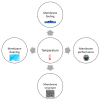A Review of Temperature Effects on Membrane Filtration
- PMID: 38248695
- PMCID: PMC10819527
- DOI: 10.3390/membranes14010005
A Review of Temperature Effects on Membrane Filtration
Abstract
Membrane technology plays a vital role in drinking water and wastewater treatments. Among a number of factors affecting membrane performance, temperature is one of the dominant factors determining membrane performance. In this review, the impact of temperature on membrane structure, fouling, chemical cleaning, and membrane performance is reviewed and discussed with a particular focus on cold temperature effects. The findings from the literature suggest that cold temperatures have detrimental impacts on membrane structure, fouling, and chemical cleaning, and thus could negatively affect membrane filtration operations and performance, while warm and hot temperatures might expand membrane pores, increase membrane flux, improve membrane chemical cleaning efficiency, and interfere with biological processes in membrane bioreactors. The research gaps, challenges, and directions of temperature effects are identified and discussed indepth. Future studies focusing on the impact of temperature on membrane processes used in water and wastewater treatment and the development of methods that could reduce the adverse effect of temperature on membrane operations are needed.
Keywords: membrane cleaning; membrane filtration; membrane fouling; membrane structure; water temperature.
Conflict of interest statement
The authors declare no conflict of interest.
Figures
References
-
- Pearce G. Introduction to membranes: Filtration for water and wastewater treatment. Filtr. Sep. 2007;44:24–27. doi: 10.1016/S0015-1882(07)70052-6. - DOI
-
- Yoon Y., Amy G., Cho J., Her N. Effects of retained natural organic matter (NOM) on NOM rejection and membrane flux decline with nanofiltration and ultrafiltration. Desalination. 2005;173:209–221. doi: 10.1016/j.desal.2004.06.213. - DOI
-
- Jung C.-W., Son H.-J., Kang L.-S. Effects of membrane material and pretreatment coagulation on membrane fouling: Fouling mechanism and NOM removal. Desalination. 2006;197:154–164. doi: 10.1016/j.desal.2005.12.022. - DOI
Publication types
Grants and funding
LinkOut - more resources
Full Text Sources


